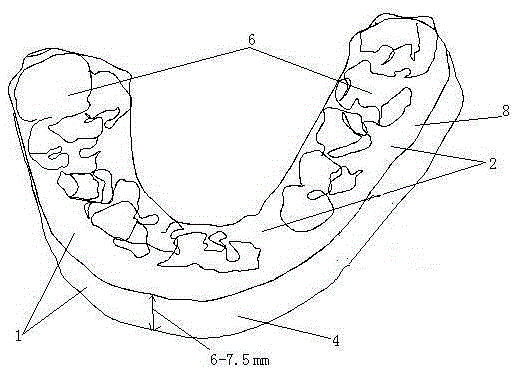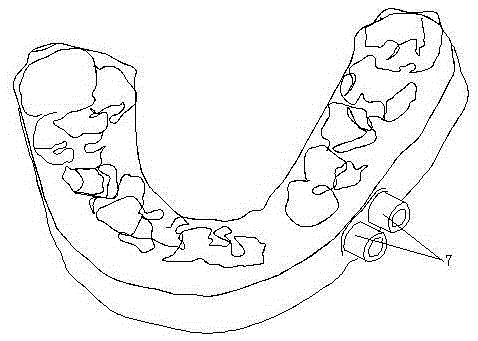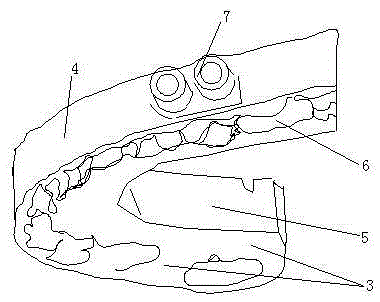CT (computerized tomography) and CBCT (cone beam computerized tomography) fusion data based digital occlusion guide plate and reconstruction method thereof
A technology for occlusal guides and guides, which is applied in the fields of radiological diagnosis instruments, computer-aided planning/modeling, medical science, etc. The effect of operation time, low cost and low technical requirements
- Summary
- Abstract
- Description
- Claims
- Application Information
AI Technical Summary
Problems solved by technology
Method used
Image
Examples
Embodiment 1
[0040] A digital occlusal guide based on CT and CBCT fusion data, including a guide body, the guide plate is hoof-shaped, with a guide plate maxillary surface, a guide plate mandibular surface, a guide plate lip outside and a guide plate lip inside, a guide plate maxillary surface, a guide plate mandible Grooves are respectively provided on the surface, and the shape of the groove fits with the shape of the corresponding tooth crown. The maxillary face of the guide accommodates the upper teeth, the mandibular face of the guide accommodates the lower teeth, and the grooves accommodate the reduced teeth. The groove depth is 1 / 3-1 / 2 of the tooth crown. The thickness of the outer edge of the maxillary surface of the guide plate is 1.0-1.5mm, preferably including the upper and lower teeth, and the upper lip side and the lower jaw lingual side are reserved. Correspondingly, the thickness of the inner edge of the mandibular surface of the guide plate is also 1.0-1.5mm, and the thick...
Embodiment 2
[0042] A digital occlusal guide based on CT and CBCT fusion data, including the guide body and the groove of the connecting rod of the bracket. Grooves are respectively provided on the maxillary face and the mandibular face of the guide plate, and the shape of the groove fits the shape of the corresponding tooth crown; the groove of the bracket connecting rod is arranged on the outer side of the lip of the guide plate. The maxillary face of the guide accommodates the upper teeth, the mandibular face of the guide accommodates the lower teeth, and the grooves accommodate the reduced teeth. The groove depth is 1 / 3-1 / 2 of the tooth crown. The thickness of the outer edge of the maxillary surface of the guide plate is 1.0-1.5mm, preferably including the upper and lower teeth, and the upper lip side and the lower jaw lingual side are reserved. Correspondingly, the thickness of the inner edge of the mandibular surface of the guide plate is also 1.0-1.5mm, and the thickness of the lab...
Embodiment 3
[0046] Aiming at the difficulty of occlusal relationship reconstruction and the need to improve the surgical accuracy of traditional models, this patent uses three-dimensional design software to simulate surgical reset and reconstruct occlusal relationship, so as to design an occlusal guide plate for intraoperative reconstruction of occlusal relationship. The specific manufacturing method Include the following specific steps:
[0047] 1. Data Acquisition
[0048] The CBCT and spiral CT scans were performed on the patients respectively, and the data of the CBCT of the dentition and the spiral CT of the head were obtained.
[0049] At present, there are many ways to obtain data, and the data closely related to maxillofacial fractures mainly include CT data, CBCT data, laser scanning data, etc. Among them, the laser scan data with the highest accuracy can reach 20 μm, including facial scan data and dentition scan data, among which facial scan data has been widely used in the stu...
PUM
 Login to View More
Login to View More Abstract
Description
Claims
Application Information
 Login to View More
Login to View More - R&D
- Intellectual Property
- Life Sciences
- Materials
- Tech Scout
- Unparalleled Data Quality
- Higher Quality Content
- 60% Fewer Hallucinations
Browse by: Latest US Patents, China's latest patents, Technical Efficacy Thesaurus, Application Domain, Technology Topic, Popular Technical Reports.
© 2025 PatSnap. All rights reserved.Legal|Privacy policy|Modern Slavery Act Transparency Statement|Sitemap|About US| Contact US: help@patsnap.com



